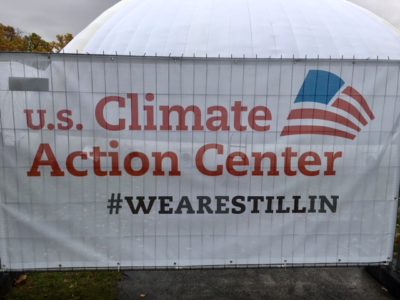
Sign outside the alternative U.S. pavilion in Bonn, dedicated to climate action
So what’s up with the Paris Agreement now that the U.S. has announced its intent to withdraw? The main annual UN conference on climate change is underway in Bonn, Germany, and UCLA Law is on the ground here. We’ll be reporting this week on what we see and hear.
This conference, which serves as the annual Paris Agreement gathering, has an official agenda that includes developing the details necessary to bring that document to life. The Paris Agreement is a landmark text and has achieved very wide participation, with all countries now on board (Syria joined the fray just last week; and the U.S. can’t officially withdraw under Agreement rules for years–though its participation now has a huge asterisk, obviously). That wide participation was made possible in part through constructive ambiguities in the Paris Agreement itself. Put simply, it is not yet clear what countries will have to do under the Agreement, beyond the main outlines. Countries are now trying to resolve these ambiguities through creation of what’s being called the “Paris rulebook.” The rulebook will spell out requirements for, among other things, the periodic pledges countries must make under the Agreement; for country reports on progress made under those pledges; for groundtruthing emission reports; and for taking stock, globally, of our collective progress toward shared goals. The Paris rulebook is due to be finalized by the end of next year, and this year’s official agenda seeks incremental progress. So far, it seems slow going even as against that modest measure. It’s hardly the stuff of Eiffel Tower fireworks.
This year’s conference, however, has had fireworks of its own, largely because of two narratives that have overtaken the official agenda.
First, U.S. states, businesses, cities, and others have absolutely swamped this conference with defiance against Trump and his climate stance. I can’t walk anywhere without tripping into a U.S. governor (or four) talking about the #wearestillin movement and the collective will to make progress toward Paris Agreement goals notwithstanding the official U.S. position. Businesses from Microsoft to Walmart are talking about the economic benefits of climate action. The Trump team’s pro-coal event yesterday was
drowned out by protesters so loud, their songs echoed through a nearby park. (I had failed to secure a spot in that event because interest in protesting against it was so large, hundreds of folks lined up hours in advance to attend.) Some meaningful announcements are accompanying all the talk: Virginia’s governor has reaffirmed
his state’s push, all but secured by the recent election outcomes, to control Virginia’s power plant emissions with a new trading program consistent with RGGI. A slate of northeast states announced
a new collaboration to tackle transportation emissions. (Let me give a shout-out here to Georgetown Law’s climate center, which is serving a key role coordinating those transportation efforts.) Generally, the UN has made a push to propel and to recognize the contributions of so-called “non-state actors” (everyone except countries) for a while–see, for example, the
Marrakech Partnership for Global Climate Action. But this level of energy is extraordinary, and it speaks to the power of Trump to create unprecedented solidarity among those who disagree with him. (Ann has been
noting this for a while!)
The second narrative, emerging just in the last day or so, is less rosy. Climate scientists at the Global Carbon Project released
their annual update on emission trends yesterday, and it looks like 2017 global emissions are up starkly, a very bad sign after a few years of flat or declining numbers. See
Scientific American’s write-up. The scientists hosted a couple of depressing events here yesterday going over these numbers and their implications, making clear how hard it will be to hew to a global emissions curve consistent with 2 degrees of warming (never mind 1.5). This is especially true if one doubts, as they do, the potential for negative emission technologies to rescue us. (A wonderful and nicely timed
Elizabeth Kolbert piece has lots more on that crucial question.)
In sum: The buzz in Bonn is an exciting, if discordant, mix of (1) climate optimism driven by the sheer volume of state and local Trump defiance; and (2) dismal realism driven by the hard math of emissions trajectories. Needless to say, it’s not yet clear how to, or whether we can, bridge the two–except to keep on trying.
Look for more reports to come from my intrepid students later in the week.
